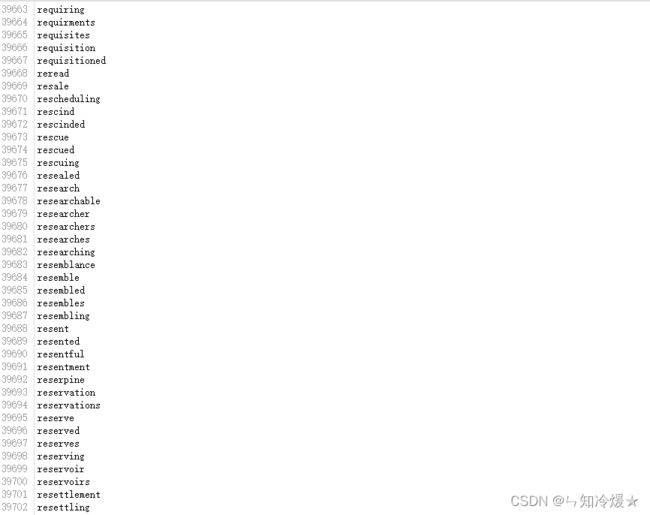NLP项目(二)——拼写纠错
目录
- 前言
- 一、数据集介绍
-
- 1-1、spell-errors.txt
- 1-2、vocab.txt
- 1-3、testdata.txt
- 二、拼写纠错代码
-
- Part0:构建词库
- Part1:生成所有的候选集合
- Part2:读取语料库,为构建语言模型准备
- Part3:构建语言模型,Bigram
- Part4:构建每个单词的错误单词输入概率的词典。
- Part5:使用测试数据来进行拼写纠错
- 总结
前言
在自然语言处理的过程中,我们常常会遇到一些拼写错误的单词,这时候我们需要用到拼写纠错来处理这些单词。
一、数据集介绍
1-1、spell-errors.txt
# 该数据集包含正确的单词以及常见的拼写错误的单词。
1-2、vocab.txt
# 该数据集是一个词库,
1-3、testdata.txt
# 该数据集是测试集。
二、拼写纠错代码
Part0:构建词库
import numpy as np
import re
import pandas as pd
# 构建词库
word_dic = []
# 通过迭代器访问: for word in f
# 用列表生成式直接将数据加入到一个空的列表中去
with open('./vocab.txt', 'r') as f:
word_dic = set([word.rstrip() for word in f])
Part1:生成所有的候选集合
import string
def generate_candidates(word=''):
"""
word: 给定的错误输入
返回的是所有的候选集合
生成编辑距离为1的单词
1、insert
2、delete
3、replace
"""
# string.ascii_lowercase: 所有的小写字母
letters = ''.join([word for word in string.ascii_lowercase])
# 将单词分割成一个元组,把所有的可能性添加到一个列表中去。
# [('', 'abcd'), ('a', 'bcd'), ('ab', 'cd'), ('abc', 'd'), ('abcd', '')]
splits = [(word[:i],word[i:]) for i in range(len(word)+1)]
# 遍历字母,遍历所有的分割,把他们组合起来
# 插入到所有可能的位置
inserts = [L+i+R for L,R in splits for i in letters]
# delete
# 每次都是删除R的第一个元素(如果R存在的话)
deletes = [L+R[1:] for L,R in splits if R]
# replace
# 替换嘛。就是插入和删除的合体。
replaces = [L+i+R[1:] for L,R in splits if R for i in letters]
return set(inserts+deletes+replaces)
def generate_edit_two(word=''):
"""
给定一个字符串,生成编辑距离不大于2的字符串。
"""
# # 第一步,先生成编辑距离为1的候选集合。
# edit_one = generate_candidates(word)
# # 第二部,遍历编辑距离为1的候选集合,对每个元素都再次使用函数
# all_lis = []
# for i in edit_one:
# all_lis.extend(generate_candidates(i))
# 上边的方法也可以直接写成一个列表生成式
return set([j for i in generate_candidates(word) for j in generate_candidates(i)])
Part2:读取语料库,为构建语言模型准备
# shift+tab 来调出函数的具体说明
# 读取一些句子,为了构建语言模型做准备。
# 从nltk中导入路透社语料库
# 路透社语料库
from nltk.corpus import reuters
# 输出语料库包含的类别
categories = reuters.categories()
# corpus:包含许多句子的集合。
# 每个句子是列表形式:['ASIAN', 'EXPORTERS', 'FEAR', 'DAMAGE']
corpus = reuters.sents(categories=categories)
Part3:构建语言模型,Bigram
# term_count: 代表所有字符以及其个数组成的一个字典。(单个字符)
term_count = {}
# bigram_count:双字符字典
bigram_count = {}
for doc in corpus:
# 每一个句子都加上起始符
doc = [''] + doc
# 遍历每一个句子的每一个字符,并将其个数记载入term_count字典里。
for i in range(len(doc)-1):
# term: 当前字符
term = doc[i]
# bigram:当前字符以及后一个字符组成的列表
bigram = doc[i:i + 2]
if term in term_count:
term_count[term] += 1
else:
term_count[term] = 1
# 把bigram变换成一个字符串。
bigram = ' '.join(bigram)
if bigram in bigram_count:
bigram_count[bigram] += 1
else:
bigram_count[bigram] = 1
Part4:构建每个单词的错误单词输入概率的词典。
# 用户通常输入错的概率 - channel probability
channel_prob={}
# 打开拼写纠错记事本
with open("./spell-errors.txt", 'r', encoding='utf8') as f:
# 遍历每一行
for line in f:
# 用冒号来进行分割
# raining: rainning, raning变为['raining', ' rainning, raning\n']
temp=line.split(":")
# 正确的单词是列表里的第一个字符串并且去除掉前后空格
correct=temp[0].strip()
# 错误的单词是列表里的第二个字符串并且以逗号分隔开的几个单词。
mistakes=[sub_mis.strip() for sub_mis in temp[1].strip().split(",")]
# 将每一个单词和他的每个错误单词的比例组成一个键值对。
# 键是正确单词,值是一个花括号。
channel_prob[correct]={}
for mis in mistakes:
# 嵌套词典
# 值是该错误单词占所有错误单词的比例
channel_prob[correct][mis]=1.0/len(mistakes)
# 最终结果如下
# {'raining': {'rainning': 0.5, 'raning': 0.5}}
Part5:使用测试数据来进行拼写纠错
V = len(term_count)
# 打开测试数据
with open("./testdata.txt", 'r', encoding='utf8') as f:
# 遍历每一行
for line in f:
# 去掉每一行右边的空格。并且以制表符来分割整个句子
items = line.rstrip().split('\t')
# items:
# ['1', '1', 'They told Reuter correspondents in Asian capitals a U.S.
# Move against Japan might boost protectionst sentiment in the U.S. And lead to curbs on
# American imports of their products.']
# 把\.去掉,每个句子刚好在items的下标为2的位置。
line = re.sub('\.', '', items[2])
# 去掉逗号,并且分割句子为每一个单词,返回列表
line= re.sub(',', '', line).split()
# line:['They', 'told', 'Reuter', 'correspondents', 'in', 'Asian',
# 'capitals', 'a', 'US', 'Move', 'against', 'Japan', 'might', 'boost', 'protectionst',
# 'sentiment', 'in', 'the', 'US', 'And', 'lead', 'to', 'curbs', 'on', 'American', 'imports', 'of', 'their', 'products']
# 遍历词语列表
for word in line:
# 去除每一个单词前后的逗号和句号。
word=word.strip('.')
word=word.strip(',')
# 如果这个单词不在词库中。
# 就要把这个单词替换成正确的单词
if word not in word_dic:
# Step1: 生成所有的(valid)候选集合
candidates_one = generate_candidates(word)
# 把生成的所有在词库中的单词拿出来。
candidates= [word for word in candidates_one if word in word_dic]
# 一种方式: if candidate = [], 多生成几个candidates, 比如生成编辑距离不大于2的
# TODO : 根据条件生成更多的候选集合
# 如果candidates为空的话,则接着生成编辑距离为2的。
if len(candidates) < 1:
candidates_two = generate_edit_two(word)
candidates = [word for word in candidates_two if word in word_dic]
if len(candidates)<1:
continue
probs = []
# 计算所有候选单词的分数。
# score = p(correct)*p(mistake|correct)
# = log p(correct) + log p(mistake|correct)
# log p(mistake|correct)= log(p(correct/mistake)*p(mistake)/p(correct))
# 遍历候选词汇
# 返回score最大的candidate
# score既考虑了单个单词的概率,也考虑了与前边单词组合的概率。
for candi in candidates:
prob = 0
# a. 计算channel probability
# 如果候选词在channel_prob字典中,并且错误单词刚好在候选词对应的值处。
if candi in channel_prob and word in channel_prob[candi]:
prob += np.log(channel_prob[candi][word])
else:
prob += np.log(0.00001)
# b. 计算语言模型的概率
sentence= re.sub('\.', '', items[2])
# 得到单词在原来句子中的索引
idx = re.sub(',', '', sentence).split().index(word)
#
# items:
# ['1', '1', 'They told Reuter correspondents in Asian capitals a U.S.
# Move against Japan might boost protectionst sentiment in the U.S. And lead to curbs on
# American imports of their products.']
# 把当前单词和他的前一个单词拼接到一起。
bigram_1 = ' '.join([items[2].split()[idx-1],candi])
# 如果bigram_1在双字符词典里,并且前一个单词也在词典里
if bigram_1 in bigram_count and items[2].split()[idx-1] in term_count:
prob += np.log((bigram_count[bigram_1] + 1.0) / (
term_count[items[2].split()[idx-1]] + V))
else:
prob += np.log(1.0 / V)
# TODO: 也要考虑当前 [word, post_word]
# prob += np.log(bigram概率)
if idx + 1 < len(items[2].split()):
bigram_2 = ' '.join([candi,items[2].split()[idx + 1]])
if bigram_2 in bigram_count and candi in term_count:
prob += np.log((bigram_count[bigram_2] + 1.0) / (
term_count[candi] + V))
else:
prob += np.log(1.0 / V)
# 所有候选单词的分数都添加到probs列表里。
probs.append(prob)
#
print(probs)
if probs:
# 得到probs列表候选单词里最大的分数,把索引拿出来
max_idx = probs.index(max(probs))
# 该索引同时也对应着候选集合里的正确单词,输出错误单词和正确单词。
print(word, candidates[max_idx])
else:
print("False")
总结
关注点赞私信我获取数据集!代码来源于网络,本人仅作学习使用,如有侵权请联系我删除。


